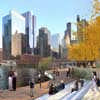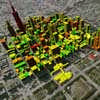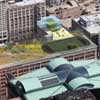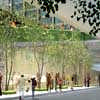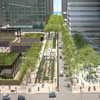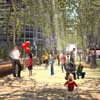Chicago Central Area DeCarbonization Plan, Building, Project, News, Design, Property, Image
Urban Development in Chicago : DeCarbonization Plan
Chicago DeCarbonization Plan 1st Phase design by AS+GG, architects
Feb 16, 2010
Chicago DeCarbonization Plan
AS+GG Completes First Phase of Chicago Central Area DeCarbonization Plan
Design: Adrian Smith + Gordon Gill Architecture (AS+GG)
CHICAGO, Feb. 16, 2010-Adrian Smith + Gordon Gill Architecture has completed the first phase of the Chicago Central Area DeCarbonization Plan, a comprehensive vision for helping the City of Chicago reach its carbon reduction goals in the downtown Loop.
Working with the City of Chicago over the past year, AS+GG has involved more than 50 members of its staff in researching and developing the DeCarbonization Plan, and is currently in discussions with city officials to consider implementation initiatives. The plan lays out a methodology for meeting the goals of the Chicago Climate Action Plan, which would mean a 25% reduction in carbon emissions below 1990 levels by 2020, and the 2030 Challenge, which set a goal of 100% reduction in carbon emissions for new and renovated buildings by 2030.
images © Adrian Smith + Gordon Gill Architecture
The second phase of the DeCarbonization Plan will focus on adapting the plan to meet the energy and carbon reduction goals of university and medical campuses, towns, cities, states and countries around the globe.
“The DeCarbonization Plan is a key element of our contribution to the future of the City of Chicago,” said Adrian Smith. “It’s a roadmap for achieving the city’s carbon reduction goals in the Loop, and we look forward to working with the city and the private sector to find ways of realizing the plan’s potential.”
“AS+GG’s DeCarbonization Plan is a creative and data-laden effort that can serve as a compelling and game-changing tool,” said Suzanne Malec-McKenna, Commissioner of the Chicago Department of Environment. “By envisioning the potential energy savings, waste handling options and redevelopment options in a framework that also considers greenhouse gas emissions reduction, the plan demonstrates both the economic and environmental values of managing large-scale properties.”
The Chicago Central Area DeCarbonization Plan articulates eight key strategies to meet the city’s carbon reduction goals. The first, “Buildings,” investigates how existing structures can be upgraded to improve energy efficiency, increase the value of aging building stock and tap into the potential to transfer excess energy loads back to the grid, all while offsetting the need for new construction. Another strategy is “Urban Matrix,” which envisions increasing the residential density of the Loop by enhancing amenities, adding schools and services and converting aging office buildings to residential.
The other strategies include “Smart Infrastructure,” a look at how energy can be generated, stored, distributed and shared; “Mobility,” an assessment of transit and connectivity; “Water,” which examines how this critical resource is used and conserved; “Waste,” an assessment of citywide processes and systems for reducing, recycling and disposal; “Community Engagement,” which proposes various programs to engage citizens in the green agenda; and “Energy,” an examination of existing and new energy sources.
“The plan is part of our drive for a broader understanding of energy and carbon and how that understanding can apply to cities and institutions,” said Gordon Gill. “One of the most exciting aspects of the plan is that it envisions a repositioning of aging buildings as real estate, transforming them from deficits to assets. Ultimately, the goal of the plan is to leverage the latent assets of the built environment to save money and invite new development with zero impact on the urban ecosystem. The result will be a new economy that improves energy and carbon performance as well as the overall quality of life in the Loop.”
Added AS+GG partner Robert Forest: “The DeCarbonization Plan provides a groundbreaking set of guidelines for achieving energy and carbon reduction goals that make both environmental and economic sense. The plan takes a holistic view of the issue from design to the funding strategies that can make implementation a reality.”
Among the DeCarbonization Plan’s concepts and proposals:
” Completing and linking a below-grade pedway system that would make the Loop more walkable in extreme weather conditions
” Creating a green corridor and below-grade inter-modal axis on Monroe Street that would offer a place of respite for residents, commuters and visitors
” Repurposing the Loop’s underground tunnels as a pneumatic waste disposal system
” Extending the existing Chicago riverwalk and bicycle paths to increase mobility within and across the Loop
” Publishing The Green City, a textbook that would enter the public and private school curricula as a primer on urban design and decarbonization for public school students, in the manner of the original Wacker’s Manual of the Plan of Chicago in 1911-1927
The DeCarbonization Plan also includes an analysis of the funding resources available to help developers and existing building owners defray the cost of green retrofits and other sustainable measures. And research for the DeCarbonization Plan acted as a catalyst for the creation of a parametric model, still under development, which will be used to calculate the carbon savings achieved by various changes to the urban environment.
The Chicago Central Area DeCarbonization Plan grew out of AS+GG’s work on an ongoing greening and modernization project at Chicago’s Willis Tower, formerly Sears Tower. AS+GG’s earliest discussions of the plan were with Sadhu Johnston, then Chicago’s chief environmental officer.
“Cities around the world are working to reduce energy and greenhouse gas emissions within existing urban areas,” said Johnston, now deputy city manager in Vancouver, B.C. “Through their work on Willis Tower, AS+GG and the Willis owners have demonstrated that there are cost-effective strategies to reduce greenhouse gases. Building off of this work, AS+GG has created a DeCarbonization Plan for an urban core, which really will be a model for cities around the world.”
Chicago Central Area DeCarbonization Plan information from AS+GG
Location: Chicago, Illinois, USA
Architecture in Chicago
Contemporary Chicago Architectural Projects
Chicago Architectural Design – chronological list
Chicago Architecture Tours – city walks by e-architect
Chicago Architecture

photo courtesy of Jan Klerks
Chicago Skyscrapers – Selection:
Sears Tower Chicago modernization and hotel
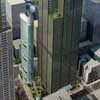
image © Adrian Smith + Gordon Gill Architecture
Comments / photos for the Chicago Central Area DeCarbonization Plan Chicago Architecture page welcome

